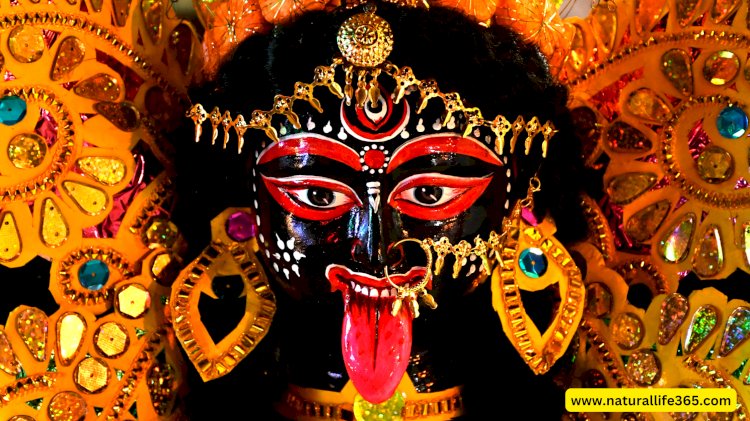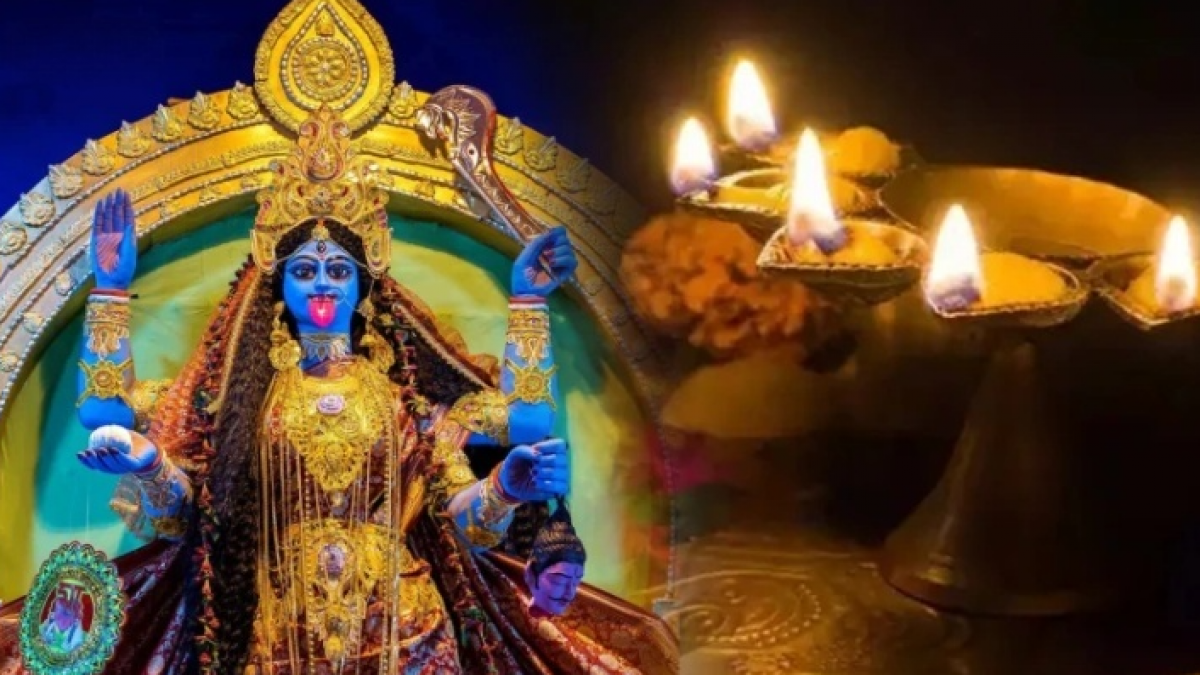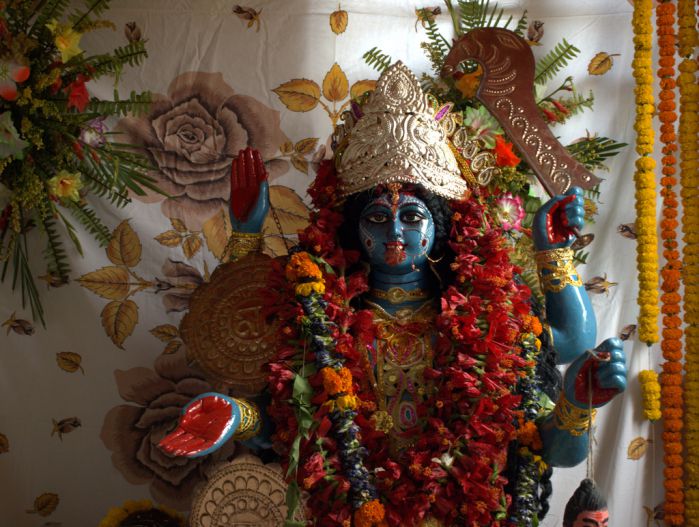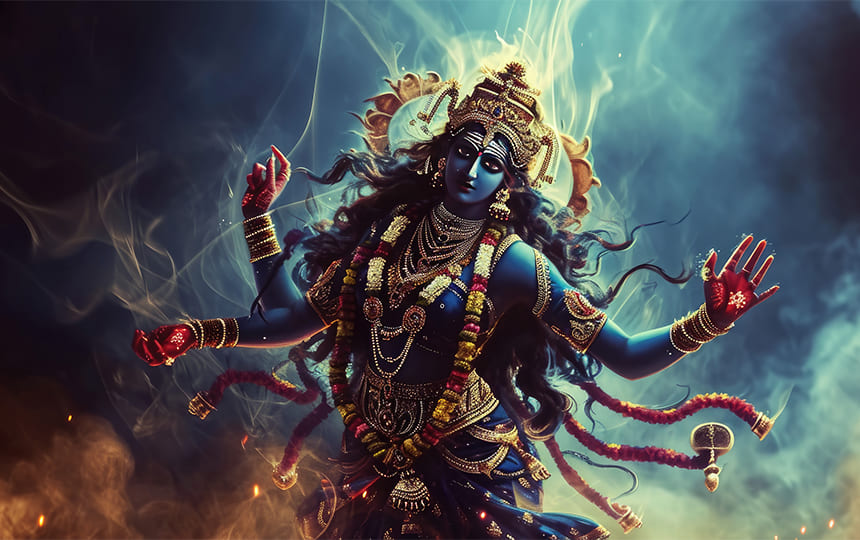The Spiritual Meaning Behind Kali Puja
Discover the deep spiritual meaning behind Kali Puja and how honoring the goddess Kali can bring inner strength, transformation, and protection into your life.

Kali Puja, an important Hindu festival that will be celebrated on 31st October 2024, is dedicated to the worship of Goddess Kali, the fierce and compassionate manifestation of the Divine Mother. Beyond the rituals and celebrations, Kali Puja holds deep spiritual significance that resonates with both personal transformation and the broader cosmic forces. This blog delves into the spiritual meaning behind Kali Puja, exploring its symbolism, rituals, and how it helps devotees transcend fear, embrace inner strength, and seek spiritual growth.
The Spiritual Significance of Kali Puja Rituals
Kali Puja, also known as Shyama Puja, primarily involves the worship of Goddess Kali through elaborate rituals that convey profound spiritual truths. The rituals performed during Kali Puja are not just for external observance but are steeped in symbolism meant to awaken higher consciousness.
The night of Kali Puja is considered spiritually significant because it represents the victory of light over darkness, knowledge over ignorance, and life over death. Kali, with her fierce form and powerful energy, symbolizes the destruction of the ego and ignorance, paving the way for spiritual awakening.
The rituals during Kali Puja—lighting lamps, offering flowers, chanting mantras, and making offerings—are all aimed at invoking the goddess's presence and receiving her blessings for strength, protection, and wisdom. Each act in the ritual represents an aspect of surrender to the Divine, seeking to rid oneself of negative energies and foster spiritual growth.
You can also read Kali Puja in Bengal: A Cultural Extravaganza Unveiled
Understanding the Deeper Meaning of Kali Puja

To understand the deeper meaning of Kali Puja, we must look beyond her fearsome appearance. Goddess Kali, often depicted with a garland of skulls, a belt of severed arms, and a bloodied tongue, embodies time (Kala), death, and the destruction of evil. However, her terrifying form is not to instill fear in her devotees but to symbolize the destruction of ego and ignorance, leading to ultimate liberation (moksha).
Kali’s black or dark-blue complexion represents the vastness of the cosmos and the infinite nature of time. She stands atop Lord Shiva, her consort, symbolizing the union of active (Shakti) and passive (Shiva) principles, illustrating that creation and destruction are part of the same cycle. Kali Puja, therefore, is an opportunity for devotees to confront their inner fears and attachments, allowing them to embrace transformation and spiritual growth.
Kali Puja for Personal Transformation and Strength
One of the key spiritual benefits of Kali Puja is personal transformation. Goddess Kali is revered as a powerful symbol of strength and destruction, but her energy is also transformative. By worshipping Kali, devotees aim to release attachments, fear, and ignorance—traits that block their spiritual growth.
Kali teaches that destruction is necessary for creation. The death of the ego is essential for personal transformation, allowing for a deeper connection with one’s higher self. Devotees often seek her blessings for inner strength, resilience, and the courage to face life's challenges with unwavering confidence. Through this process, they find themselves transformed spiritually, emotionally, and mentally.
Kali Puja encourages devotees to surrender their lower self, egoistic desires, and fears at the feet of the goddess, trusting that in her fierce love, she will remove the obstacles hindering their spiritual journey. Her protective nature provides the spiritual armor needed to undergo transformation, fostering growth and empowerment.
The Symbolism of Goddess Kali in Kali Puja

Kali is a rich symbol in the Hindu tradition, representing the cycle of life, death, and rebirth. Her dark form is a visual reminder that the universe is a place of both creation and dissolution. Each of her four arms carries symbolic weapons: a sword to cut through ignorance, a severed head symbolizing the death of the ego, and gestures of both fearlessness and blessing.
Her garland of skulls represents the souls she has freed from the bondage of illusion (maya). Her blood-red tongue, often protruding, symbolizes her insatiable thirst for truth and the raw energy of life itself. Her nakedness represents her purity, unadulterated by the illusions of the material world.
In Kali Puja, these symbols remind devotees of the deeper, spiritual realities of life—how one must face fear, death, and darkness to reach the ultimate truth and liberation.
How Kali Puja Brings Spiritual Protection
Goddess Kali is widely worshipped as a fierce protector, shielding her devotees from negative forces. Her protective energy is not limited to the physical realm; Kali is also believed to protect her followers from spiritual dangers, such as ego, ignorance, and temptation.
The spiritual protection offered by Kali is essential for those seeking to advance on their spiritual path. By invoking Kali during the puja, devotees align themselves with her power to dispel negative energies and break free from spiritual bondage. Kali's fierce demeanor is seen as a guardian of truth and righteousness, offering strength to those walking the path of dharma (righteousness).
Through her destructive energy, Kali eliminates the fears, doubts, and distractions that prevent devotees from realizing their full spiritual potential. Her blessing offers protection in all aspects of life—physical, emotional, mental, and spiritual—helping practitioners cultivate courage and resilience.
Kali Puja as a Path to Spiritual Growth

Kali Puja is not just a form of worship; it is a spiritual practice that can lead to profound growth. In Hindu tradition, Kali is seen as the ultimate teacher of life's impermanence. Her image, though terrifying, serves as a reminder of the fleeting nature of material existence and the importance of focusing on the eternal, unchanging self.
By meditating on Goddess Kali during Kali Puja, devotees learn to embrace the natural cycles of life, understanding that death is not an end but a transition. The worship of Kali becomes a path to transcend the limitations of the material world and achieve higher spiritual states.
Kali's energy challenges the limitations of the ego, helping devotees realize their divine potential. As she tears away illusions and false identities, her worshippers grow spiritually, experiencing a greater connection with the divine and a deeper understanding of the self.
The Meaning Behind Offerings in Kali Puja
The offerings made during Kali Puja carry deep symbolic meaning. Each item offered represents a specific intention and has spiritual significance. Flowers, particularly red hibiscus, are offered to Kali to symbolize life force and the victory of life over death. The red color represents both life and death, energy and destruction—qualities associated with the goddess.
Devotees often offer food items such as rice, sweets, and fruits, representing the act of surrender and gratitude for the nourishment provided by the divine. Additionally, symbolic offerings like lamps and incense signify the illumination of the soul and the purification of the mind and environment.
The offerings are a way for devotees to honor the goddess and seek her blessings. In return, it is believed that Kali accepts these offerings and grants protection, wisdom, and spiritual growth to her followers.
The Spiritual Benefits of Worshipping Goddess Kali

The worship of Goddess Kali brings numerous spiritual benefits to devotees. Her fierce energy helps devotees overcome internal obstacles, such as fear, ego, and ignorance, and leads them to liberation. Kali’s blessings help individuals develop fearlessness, inner strength, and clarity in their spiritual pursuits.
Worshipping Kali during the puja invokes her transformative energy, enabling devotees to shed old patterns and embrace new beginnings. She empowers individuals to break free from limiting beliefs, helping them tap into their inherent potential. Additionally, Kali’s grace allows devotees to experience spiritual protection and mental clarity, leading to personal and spiritual empowerment.
Through her guidance, devotees cultivate a deeper understanding of life’s impermanence, fostering detachment from material attachments and a greater focus on their spiritual journey.
Kali Puja and the Divine Feminine Energy
Kali Puja celebrates the divine feminine energy, also known as Shakti, which is the force that governs creation, destruction, and transformation. Goddess Kali, as a manifestation of Shakti, embodies the raw, untamed aspects of the feminine energy. Her wild, ferocious form contrasts with more nurturing female deities like Lakshmi and Saraswati, but it represents the balance necessary for creation.
The celebration of Kali during the puja is an acknowledgment of the power and importance of the divine feminine in spiritual growth. By worshipping her, devotees tap into the primal energy of creation and destruction, learning to balance the softer and more fierce aspects of themselves. Kali’s energy teaches that the divine feminine is not just nurturing but also capable of fierce protection and transformative change.
You can also read Celebrating Lakshmi Puja: Rituals to Welcome the Goddess of Wealth
How Kali Puja Aids in Overcoming Fear and Negativity

Kali Puja is particularly known for helping devotees overcome fear and negativity. Fear, which stems from the ego’s attachment to the material world, is a major obstacle to spiritual growth. Through the worship of Kali, devotees confront their deepest fears—of death, loss, and failure—and find the strength to transcend them.
Kali’s fierce form is a reminder that fear itself is an illusion. Her fearless stance, with her foot placed on Shiva and her sword raised, symbolizes the triumph over ignorance and fear. Devotees who worship her learn to let go of their fears and trust in the divine plan, finding peace and liberation in the process.
Additionally, Kali’s energy helps dispel negativity, whether internal or external. Her powerful presence is invoked to protect against negative forces, break destructive patterns, and purify the mind. As a result, Kali Puja is seen as a powerful ritual for those seeking to cleanse themselves of negative influences and strengthen their spiritual foundation.
So…
Kali Puja is a deeply spiritual celebration that goes beyond ritualistic worship. It is a path toward inner transformation, strength, and spiritual growth. Through the worship of Goddess Kali, devotees learn to face their fears, overcome negativity, and embrace the divine feminine energy that flows through all of creation. The spiritual significance of Kali Puja lies in its power to awaken higher consciousness, offering protection, guidance, and the opportunity for personal transformation.
By understanding the deeper meanings behind Kali Puja, devotees can connect with the fierce compassion of Goddess Kali, allowing her to guide them on their spiritual journey toward liberation and self-realization.
If you value these free online resources provided by Natural Life 365, please consider supporting my website by sharing the blogs ![]()








































